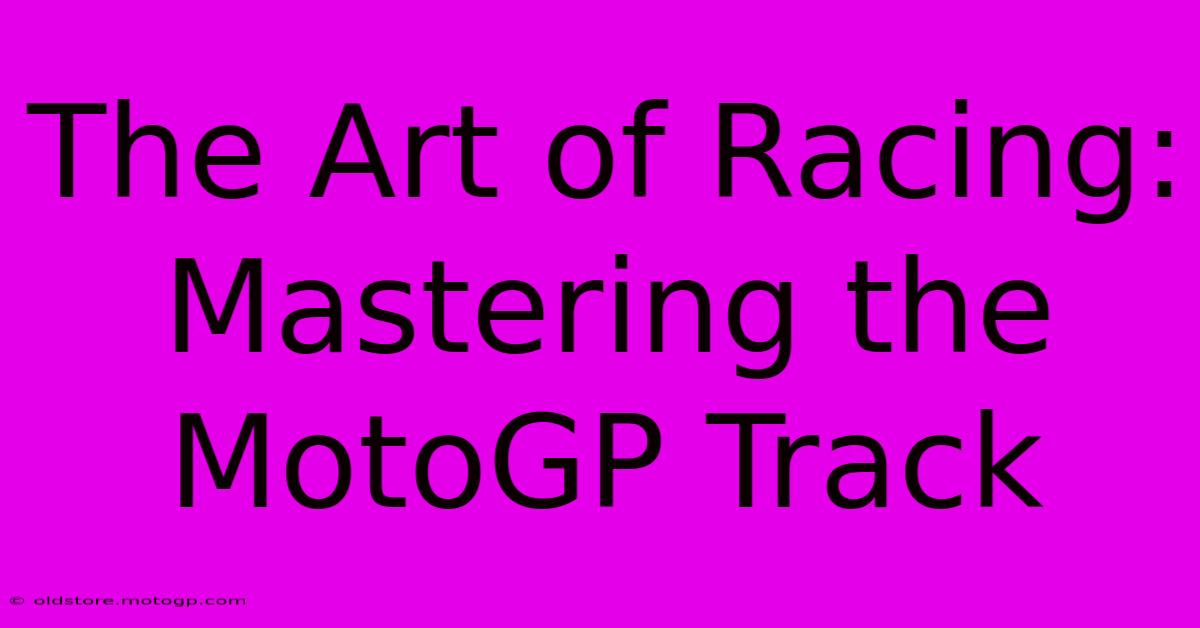The Art Of Racing: Mastering The MotoGP Track

Table of Contents
The Art of Racing: Mastering the MotoGP Track
MotoGP. The name itself conjures images of screaming engines, breathtaking speeds, and gravity-defying maneuvers. It's the pinnacle of motorcycle racing, a demanding sport requiring not just skill, but an almost artistic understanding of the track and machine. This article delves into the art of mastering the MotoGP track, exploring the key elements that separate the champions from the also-rans.
Beyond Speed: The Holistic Approach to MotoGP Success
Many believe MotoGP is simply about speed. While crucial, speed alone isn't enough to conquer these demanding circuits. True mastery involves a sophisticated blend of several key elements:
1. Understanding the Track: Line, Rhythm, and Flow
Before even touching the throttle, a rider must intimately understand the track. This means more than just memorizing the turns. It's about identifying:
- Optimal racing line: Finding the fastest, most efficient path through each turn, maximizing speed and minimizing time loss. This line often varies depending on factors like tire wear and track conditions.
- Turn entry and apex: Precisely judging the braking point, and selecting the ideal apex for maximum exit speed. This requires a deep understanding of bike dynamics and physics.
- Rhythm and flow: Maintaining a consistent and fluid rhythm throughout the lap, maximizing momentum and minimizing abrupt changes in direction. This is where the "art" truly shines. Smoothness is power.
2. Bike Setup and Control: A Symphony of Machine and Rider
The MotoGP bike is a highly sophisticated machine, requiring meticulous setup. Riders work closely with their teams to fine-tune various aspects, including:
- Suspension: Optimizing suspension settings for the specific track conditions, ensuring optimal grip and stability.
- Electronics: Utilizing advanced electronic systems such as traction control, wheelie control, and engine braking to manage power and maintain control, especially crucial on uneven surfaces or during aggressive maneuvers.
- Ergonomics: Ensuring a perfect fit between rider and bike, maximizing comfort and control.
Mastering these aspects transcends mere mechanical understanding; it's about feeling the bike as an extension of oneself.
3. Tire Management: A Delicate Balance
Tire management is paramount in MotoGP. Pushing the limits of grip while preserving tire life for the entire race requires immense skill and strategic thinking. Factors such as temperature, track conditions, and riding style all influence tire wear. Experienced riders anticipate these factors, adapting their riding style and conserving tire life strategically.
4. Overtaking and Racecraft: The Art of Combat
MotoGP is not a solo event; it's a fierce battle for position. Overtaking requires precision, courage, and a deep understanding of racing strategy. Successful overtaking involves:
- Finding the right opportunity: Identifying openings where the rider can safely and effectively pass another competitor.
- Clean and fair racing: Respecting other riders while aggressively pursuing victory. Collisions can be costly, both in terms of time and injuries.
- Race awareness: Maintaining awareness of the positions of other racers and adapting strategies accordingly.
5. Mental Fortitude: The Unsung Champion
Beyond the physical demands, MotoGP requires exceptional mental strength. The pressure, the risk, and the intense competition demand laser focus, resilience, and an unwavering belief in oneself. This mental game is as vital as the physical prowess.
The Future of MotoGP: Technology and Evolution
MotoGP is a constantly evolving sport. Advancements in technology and the relentless pursuit of speed push the boundaries of what's possible. Future developments will likely involve:
- Further refinement of electronics: Providing even greater control and precision.
- Improved aerodynamics: Enhancing speed and stability.
- Sustainable fuels and materials: Reducing the environmental impact of the sport.
The art of racing in MotoGP continues to evolve, demanding adaptation and innovation from riders and teams alike.
Conclusion: The Enduring Appeal of MotoGP
The mastery of the MotoGP track is a blend of science, skill, and artistry. It's a relentless pursuit of speed, precision, and strategic thinking, wrapped in an atmosphere of intense competition and risk. The enduring appeal of MotoGP lies in witnessing this incredible blend of human skill and technological marvel. The champions are not just fast; they are masters of the art of racing.

Thank you for visiting our website wich cover about The Art Of Racing: Mastering The MotoGP Track. We hope the information provided has been useful to you. Feel free to contact us if you have any questions or need further assistance. See you next time and dont miss to bookmark.
Featured Posts
-
Racing Souvenirs You Ll Cherish Circuit Of The Americas Store
Feb 20, 2025
-
Moto Gp Announcers Their Dedication To The Sport
Feb 20, 2025
-
Moto Gp Qualifying The Road To Victory Begins
Feb 20, 2025
-
Edge Of Your Seat Action Tnt Sports Moto Gp
Feb 20, 2025
-
Formula 1 Parking Pass Your Reserved Spot Awaits
Feb 20, 2025
